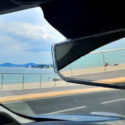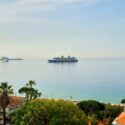The electric car is making headlines in the last few years. As the distribution of electric cars as well as electric hybrid cars is increasing on the roads of Europe, one of the questions that come up is just how far can you travel on one charge with an electric car?
A trip across Western Europe from the north by the English Channel, to the south coast in Spain, might be too much for one charge for an electric car. But what if we narrow the focus and look at a few smaller countries that are bordering one another, such as Benelux (Belgium, Netherlands, and Luxembourg)? And what if we travel with an electric hybrid car to improve the fuel economy? The situation then becomes quite different. With a Toyota Yaris Hybrid³ car, we had a glimpse of the reality with car that does not run only on fossil fuel and that improves the fuel economy with a combination of a combustion engine and an electric propulsion system.
From the Netherlands to Luxembourg
For our journey to find inspiration, we tested the Toyota Yaris Hybrid³ from the Netherlands to Luxembourg for a long weekend with good food and exploring the wine region in Luxembourg by the river Moselle. It was a journey of some seven hours with stops for food along the way, we passed through the BeNeLux on the highway network. This was part holiday and part an experiment to get a feeling for the hybrid car as a transport method. The combination of the short distances between Netherlands, Belgium, and Luxembourg played a part in the feasibility.
Although we traveled with a hybrid electric car that improves the fuel economy by recharging during normal driving³, for those traveling with electric cars it is noteworthy how charging stations in Netherlands were readily available.
The well-developed infrastructure for charging stations enables travel with an electric car without having to worry about running out of battery charge along the way.
Perspective on cars running on petrol in the EU
According to a publication in July 2022 by ACEA, 40% of all new cars in the EU run on petrol[1]. The European Automobile Manufacturer’s Association (ACEA) was founded relatively recently in 1991 when the car industry was already well established in Europe. Over the years the association has united 16 of the largest makers of cars, trucks, vans, and buses in Europe.
So that statistic from 2020 is a sign that we have already passed the point with a majority of cars that are not (only³)dependent on petrol as the energy source. The trend since 2018 shows how battery electric, plug-in hybrid, and hybrid electric cars have grown substantially. HEV³ cars had the largest proportion in 2021 (19.6%) with battery electric cars almost half of that (9.1%). Plug-in hybrid cars are not far behind, with an 8.9% proportion of all the new cars registered in the EU.
Combustion engines meet resistance
If we look back to 2020, a report by the European Environment Agency showed that registrations of electric cars jumped by several percent in that year, compared to the years 2015–2019[2]. The diesel-engine cars are therefore waning in popularity.
Entering Belgium from the Netherlands
After a while, it becomes obvious that the road maintenance was not really up to the same standard as before. But other differences more relevant to our hybrid car were also visible. We passed by fewer gas stations and the ones that we did encounter were huddled together in very compact areas.
So whether traveling by electric car, hybrid electric car, or a car with an internal combustion engine, to refuel does matter as you travel around in this region. But thanks to the relatively short distances in both Belgium and Netherlands, we easily had more than 100 kilometers left of our range as we drove into Luxembourg.
The quick passage through Luxembourg
Luxembourg is one of the smallest countries in Europe. From the northern tip of the country to Luxembourg City in the far south, it takes slightly less than three hours by car. We noted that this five-star hotel had a very makeshift EV-charging station for those traveling with an electric car.
One might not as readily expect that 2- or 3-star hotels would offer the same. Therefore you would have to find EV-charging stations in the vicinity of your destination.
If you are planning for a holiday with an electric car in BeNeLux, your travel planning really should include where and how to charge your EV car.
Three takeaways for more eco-friendly road trips: Questions to ask yourself before your road trip with a hybrid or electric car
To begin planning your holiday with an electric or hybrid car, start with these questions:
- How far will you go?
- What is the maximum distance on one tank/charge?
- What is the insurance as you travel around Europe with a rented electric hybrid car or electric car?
[1] https://www.acea.auto/figure/fuel-types-of-new-passenger-cars-in-eu/
[2] https://www.eea.europa.eu/ims/new-registrations-of-electric-vehicles
[3]Toyota Yaris 2020 is a self-charging car and as such does not rely on the charging infrastructure. Although it does not plug into a power supply, it draws energy during normal driving. See more at https://mag.toyota.co.uk/how-does-toyota-hybrid-work/ . Also see https://en.wikipedia.org/wiki/Hybrid_electric_vehicle .
By Paul-Christian Markovski, freelance writer, EuropeZigZag.com.




